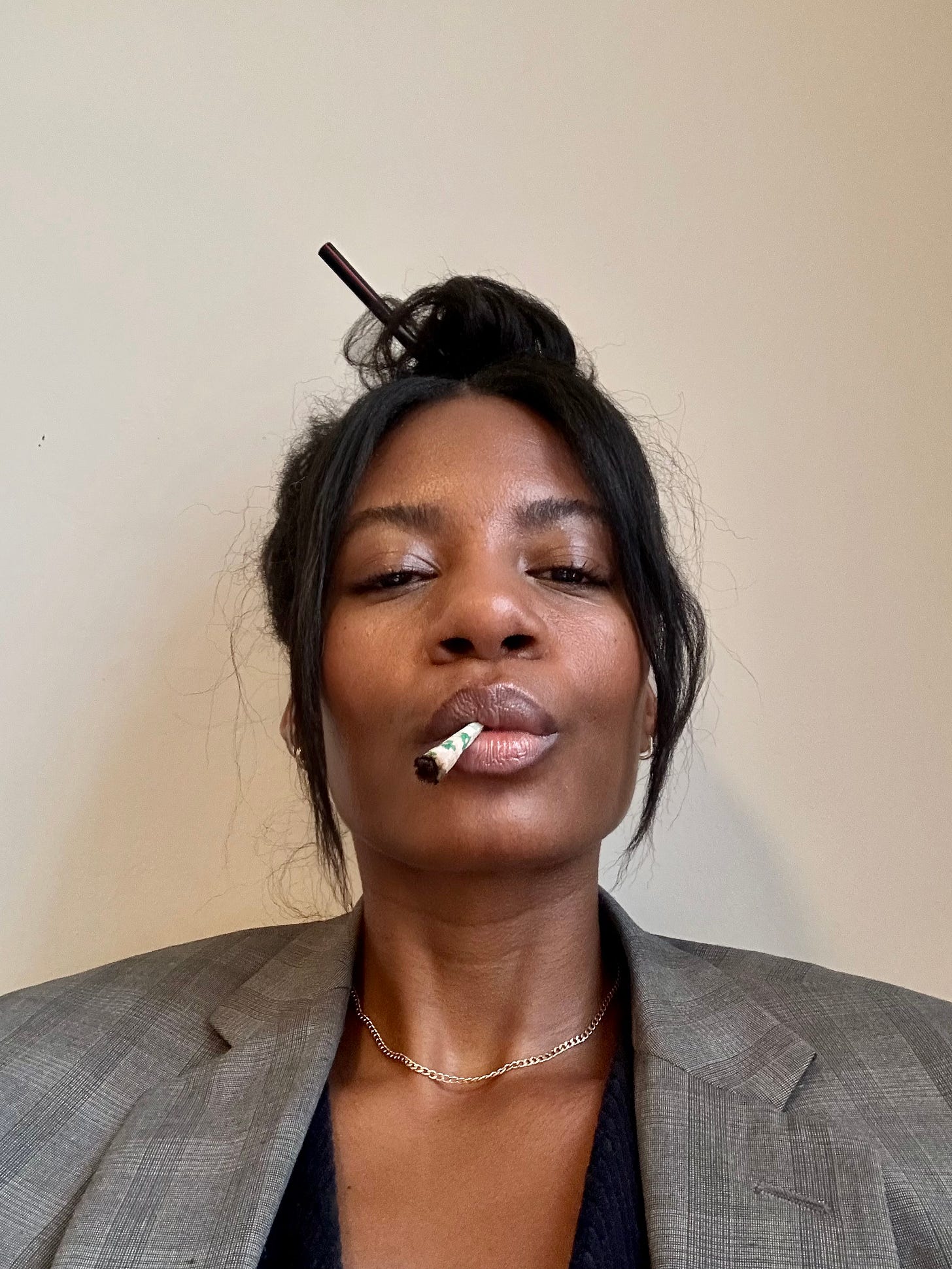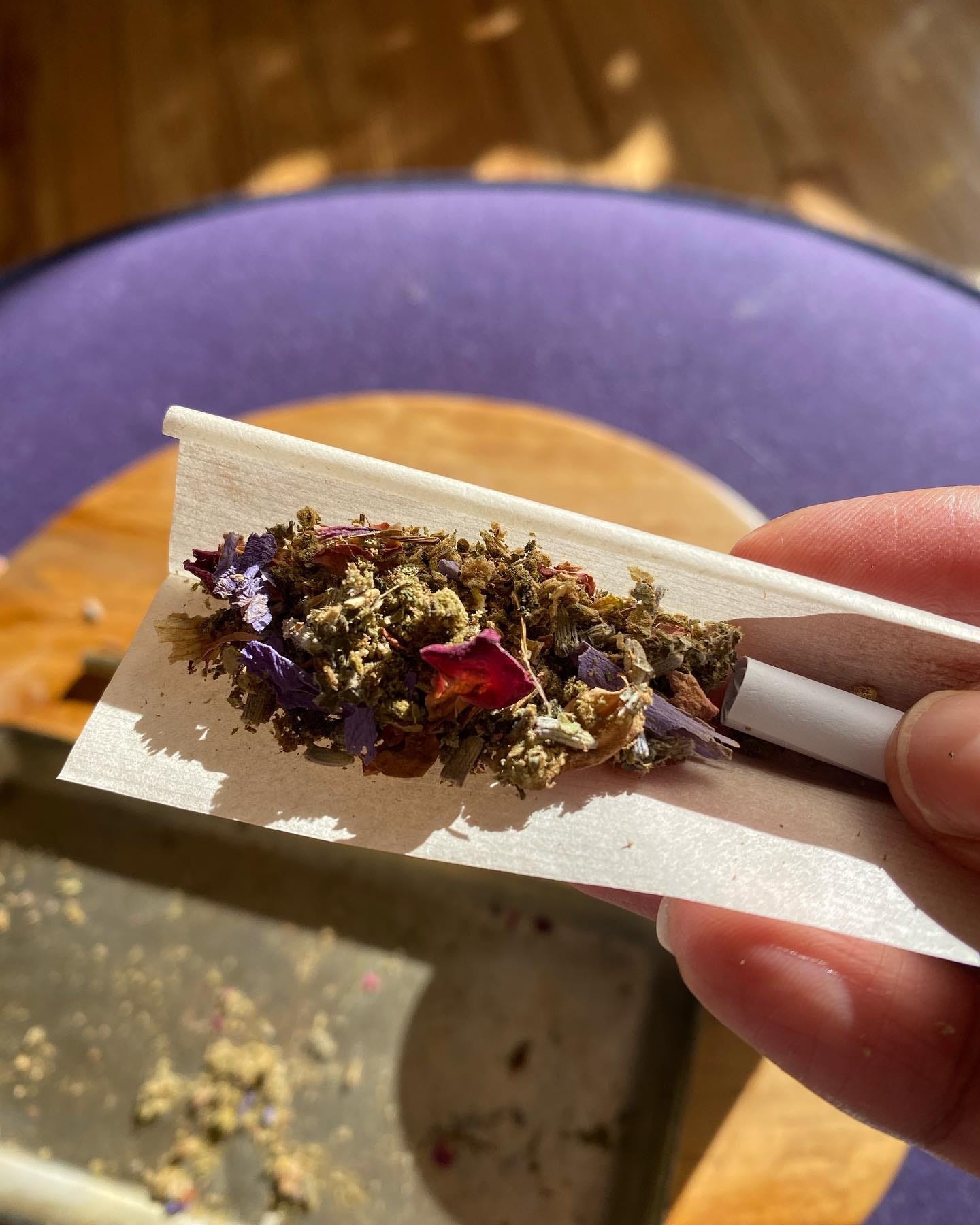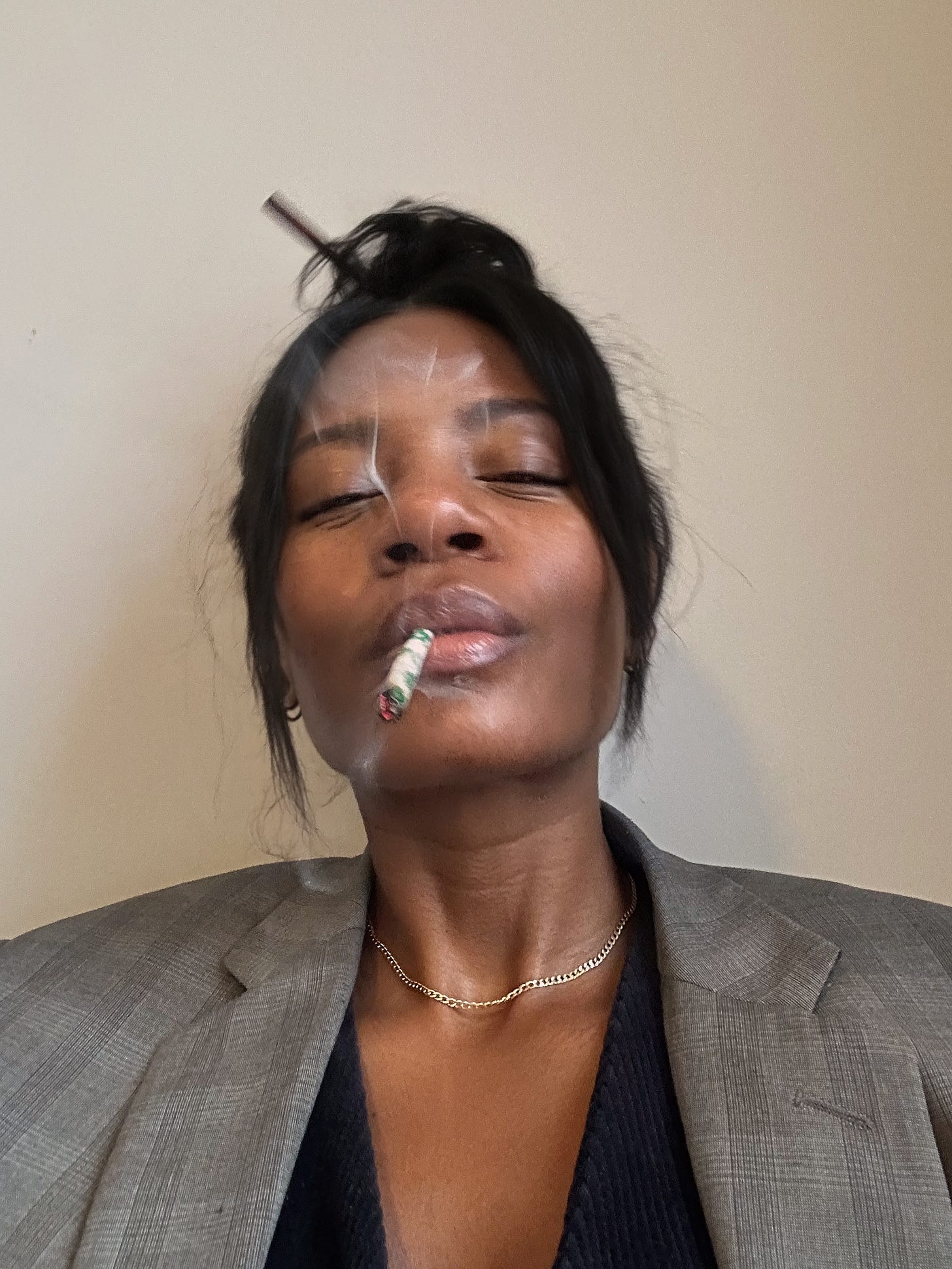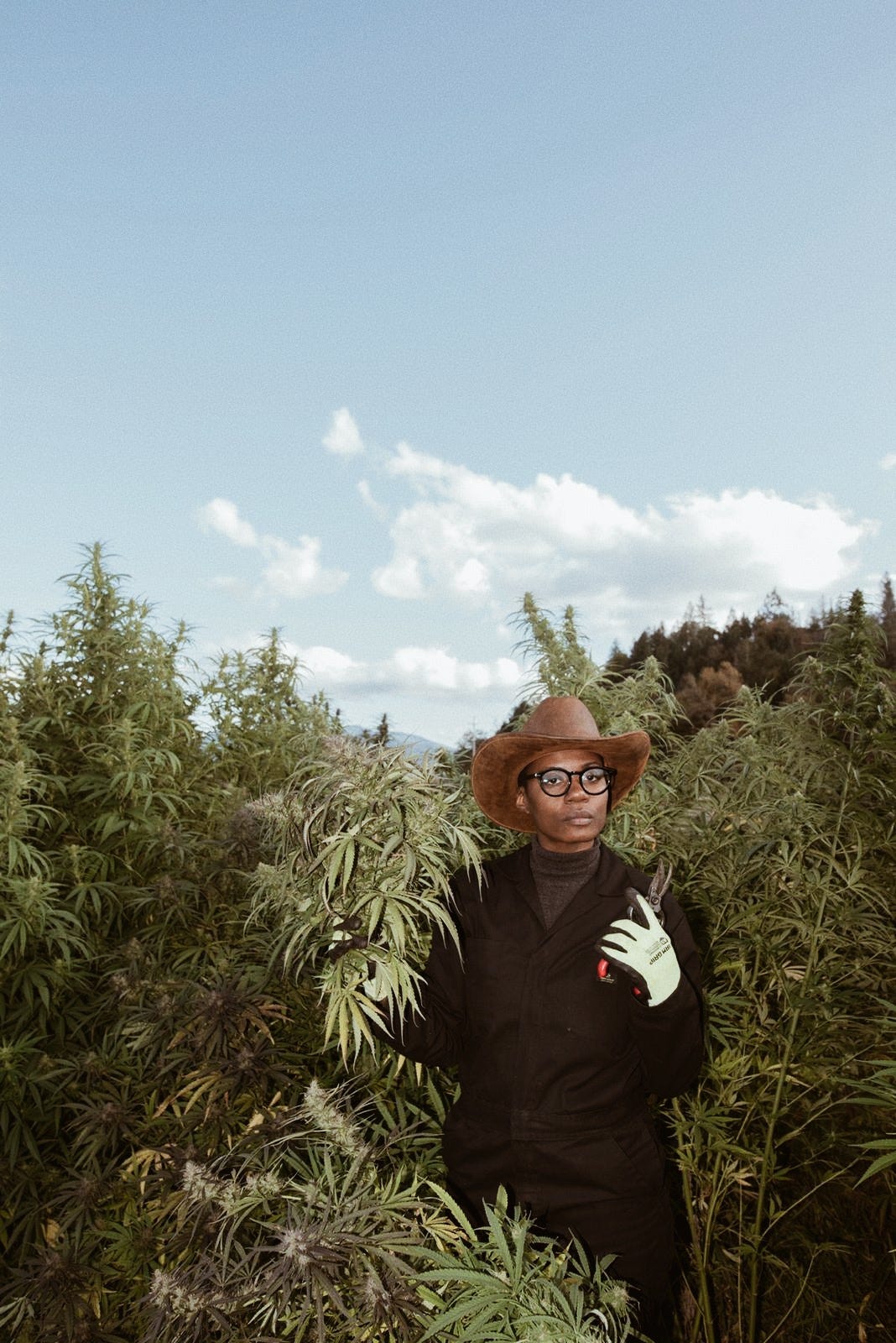24 Days Without Weed: What I Learned After 24 Years of Cannabis Use
— It's more nuanced than you think
Welcome, new subscribers, to TASTE BUD—a newsletter using foodways as a lens to explore the intersections of culture, culinary anthropology, and weed. In today’s essay, I get more personal, offering insights into my relationship with cannabis and my journey of abstinence. But if you’re looking for more food-focused content, feel free to explore my full recipe archive. Glad you’re here!

While many have become disenchanted by weed and the cannabis industry—I’ve found myself rolling into my 20th year of forging a humble living in the legalized cannabis business sector.
This path has been thorny and cold, marked by moments of solitude, but it also presents itself as a cushy, sunlit, moss-covered route that’s easy, pleasant, and inspiring. I’ve witnessed countless career pivots, grow room malfunctions, media recognition, employment dips, bountiful harvests, neighbors threatening to call the cops, and industry copycats. I’ve seen the tides change, not just as a consumer but as a cultivator and entrepreneur in the cannabis space.
My Relationship with Weed
My first interaction with weed was in 1998 outside a roller-skating rink in Amish Country, Pennsylvania. That blunt opened my young mind to the world, helped me cope with teenage angst, and the deep wounds of childhood abandonment. However, it wasn’t until I started university that my use became habitual. I smoked a bowl before walking to class, hit the blunt after class, got high before walking to the library, smoked in nightclubs, on hikes, and even while driving back home to Baltimore for semester breaks.
I’ll be the first to admit that most of the writing assignments I turned in during that time could’ve used many additional rounds of edits. In truth, I wasn’t the most focused or diligent student, yet I graduated with a mediocre 3.2 GPA. It wasn’t a 4.0, and I didn’t get to wear those cute honors cords over my gown—a bruise to my ego and my family’s legacy. Still, they were proud; I was the first in my nuclear family to graduate from college—albeit while mostly high.
Now as an auntie, I often encourage teenagers and friends with teenagers to hold off on weed and booze until age 25. According to Dr. Staci Gruber, a neuroscientist at the Marijuana Investigations for Neuroscientific Discovery Program at Harvard Medical School, “the brain remains in a developmental phase until the early to mid-20s”. During this final stage of development, the brain is especially vulnerable to potential harm caused by drug exposure. The frontal cortex, which plays a key role in planning, judgment, decision-making, and personality, is among the last areas to mature fully. This means that cannabis use at a young age can have lasting effects on who you are and the choices you make. Many would argue that alcohol, fast food, social media, and junk food impact the adolescent brain just as much, if not worse. But I digress.
Adjusting to life without cannabis
My initial expectations of the break were daunting. I knew that along with refraining from cannabis, I’d have to reflect deeply on my relationship with getting high. But moments for reflection came naturally. Confronting deep questions about my lifestyle turned out to be less scary than I’d imagined, with constant reminders—both helpful and hilarious—surrounding me.
Each morning, I found remnants of my weed life staring back at me: When I flipped open my laptop to check morning emails, while writing copy for cannabis clients, and in the face of many beautiful, design-forward smoking accessories sprinkled throughout the house. It all represented how intricately rooted cannabis is in my life. Ganja also showed up in more pensive avenues, like when I was asked to explain the difference between dependency vs. addiction during a recording for an upcoming episode of the Shelah Marie podcast. All of these moments felt like the plant itself was saying, “See, I do more than just get you high; I feed you, give you work, and hold space for you.”
On Sobriety & Abstinence
I want to be very clear: I am not trying to push anyone into cannabis use, nor am I touting sobriety as a moral flex. I am not sober—just sober curious. As my curiosity has grown, I’ve found myself exploring all different forms of abstinence over the years: taking long breaks from coffee and alcohol (especially during the luteal and menstruation phases of my cycle), abstaining from sex, dairy, and eating animal flesh. I’ve even developed dozens of alcohol-free options and weed-infused cocktails to enjoy with my sober friends when they visit.
There’s a noticeable trend toward sobriety—especially among teenagers and young adults. The CDC reports a decline in high school cannabis use, from 23% in 2013 to 17% in 2023. According to The Colorado Sun, the rate of cannabis use in youths has fallen to its lowest level in almost ten years. There’s an overall sea change in how the youth guide us toward healthier, cleaner lives. It may stem from a bleak outlook on a future fueled by consumerism and war, leading them to prefer clear-mindedness amid the chaos—a stark contrast to older generations numbing themselves.
One survey showed that nearly 41% of adults in the U.S. are drinking less alcohol, too. The sober movement, particularly regarding alcohol, highlights a desire to escape the pitfalls of numbing culture. However, as someone who doesn’t identify as sober, I recognize that discussions around sobriety should be approached with sensitivity. For those recovering from addiction, it’s a serious commitment marked by challenges and victories and deserves respect and grace. So, I’m also using this space to offer some resources (that you can find at the end of this article). And if you haven’t already read the esteemed J Wortham’s “How to Feel Visible” essay, I would start there.
Ultimately, whether one is exploring a break from cannabis, refraining from alcohol, or embracing a sober lifestyle, the underlying goal remains the same: the pursuit of well-being, authenticity and accountability. The growing interest in mindful living reflects what I think is a collective yearning for deeper connections—both with ourselves and within our communities. My hope is by respecting and highlighting my diverse and complicated narrative surrounding cannabis use; we can have a more compassionate dialogue that encourages everyone to find their unique path to health and dare I say, happiness.

What I’ve Learned (am learning) —
The good:
Quitting Isn’t as Hard as You Think: It becomes a learned habit. Once I set my mind on stopping, I became hyper-focused on keeping weed out of my system and privately informing friends—especially in situations where I knew they would be lighting up. In full disclosure, my motivation was to quit during the hiring process for a highly competitive career opportunity, but it became a means to an end.
Mindfulness Kicked In When Least Expected. Thanks to my meditation practice, I started to almost automatically turn on my mindful brain as a tool to slow down and reflect. Smoking weed has often allowed me moments to reconnect with myself, but meditation and mindfulness quickly became the means to tap into quiet observation and self-awareness. Slowing my breath and slowing my thoughts through meditation mimicked that of cannabis and it felt good.
I Didn’t Experience Many Withdrawals: Typically, cannabis withdrawals occur within 2-3 days after regular or heavy users stop abruptly, with common symptoms including irritability, sleep disturbances, depressed mood, and loss of appetite (ironically, the things you turn to cannabis to alleviate). Some might also experience chills, headaches, muscle tension, sweating, and stomach pain. I was initially nervous about potential withdrawals but ended up feeling quite normal—energized, if anything. Notably, I did experience sweating, which I’ve attributed to perimenopausal symptoms that have crept up on me in recent years. If this were part of an actual study, a full two months to a year might provide a clearer picture. So stay tuned.
Strengthening Relationships: While I felt vulnerable without my favorite vice, I became more open to connection. I noticed a significant shift: without cannabis, I was more receptive to authentic interactions. My social life often revolved around weed, but this period highlighted that meaningful connections are rooted in presence, not substances. I reached out more to friends and family, discovering depths in those connections that surprised me. I’ve always been this way, even when I’m using herb. But this experience clarified that true intimacy hinges on how we engage with each other.
The problematic:
Increase of other substances. I noticed a significant increase in my intake of coffee, matcha, snacks, treats and desire for alcohol. I began using food and consumption of all kinds as rewards—indulging in an ice cream sandwich for a job well done or downing two extra cups of coffee in the afternoon. Whenever a weed craving whispered, “a joint would be nice right now,” I turned to my poorly made matcha oat milk lattes as a reflex. Surprisingly, this distraction helped shift my focus from what I couldn’t have to what I could have. In many recovery circles the concept of “delay and distract” is useful and was a part of my strategy for managing cravings, but it’s also helped particularly with my procrastination and ADHD impulses. This is mostly a good thing, but potentially could be problematic if not monitored.
Perception and Struggles with Identity: People often assume I’m smoking weed all day and doing nothing else; reflecting a stigma that paints cannabis users as unproductive, lazy, and addicted. This narrow view ignores the reality that many cannabis users lead fulfilling, successful lives. I’ve often felt boxed in by my weed identity; despite my extensive writing and research on food, herbs, and other aspects of my career. While I take the title “weed tía” as a badge of honor, the oversimplification has cost me jobs, relationships, and respect. The stigma surrounding cannabis use disregards the nuanced realities of those who can balance their habits with productivity, leading me to question, “What is my identity without weed?” If I stop consuming altogether, would I then be a fraud?
Heightened Sensitivity to Stress: Before my break, smoking a J was my go-to for stress relief, an easy escape to regain positivity and sometimes motivation. During this time, when faced with anxiety and irritability—common in my menstrual cycle’s luteal phase—I felt scared without that familiar relief. Essential but alarming, I quickly realized I had to learn how to self-soothe and cope with stress in new ways. Strategies like meditation, journaling, and allowing myself to cry when needed proved helpful. But in truth, cannabis had been better suited for my stress relief.
Pressure of Expectations: Explaining my break to others often left me feeling judged. Questions about why I was stopping made me defensive, as if I had a problem that necessitated a break. At the same time, I grappled with the perception that abstaining from weed made me less authentic or connected, despite my established presence in the cannabis space. This tension between personal growth and the internalized pressures of cannabis culture is something I want to explore further.
We’ve become too exploitative. We are doing too much to weed and with weed. We want bigger buds and stronger highs.
Potential Harms from Cannabis Are Real but Rare: Cannabis Hyperemesis Syndrome (CHS) has emerged as a recognized condition, where rather than alleviating nausea and stimulating appetite, cannabis instead triggers severe vomiting and abdominal pain. While this syndrome is rare and primarily affects daily, long-term users of high-potency strains, its increase in cases reflects a broader need to understand the potential downsides of cannabis use, especially as legalization spreads. This is up to our governments to do. This is up to research and science. Yet, unfortunately, many in the industry often turn a blind eye to these issues, fearing that acknowledging such harms might hinder our progress in legalization efforts. This denial overlooks the complexity of cannabis and the reality that, while it can be beneficial for many, it can also pose serious risks for some users.
A Break Doesn’t Inherently Mean Weed Is Bad: My experiences over the years have nuanced my view of cannabis. While I plan to continue using it—especially in topical, tincture, and weed mocktail forms—my cravings and habits aren’t as prevalent as they used to be. I’m tempted to take an even longer break. This doesn’t negate the benefits cannabis offers, but it’s important for me to honestly consider ways that it works in my life and ways it doesn’t.
My takeaway
We’ve become too exploitative. We are doing too much to weed and with weed. We want bigger buds and stronger highs. Over the past decade brokers, distributors and consumers alike have demanded strains with higher THC percentages—not knowing what we really needed is high quality herb with more variety in cannabinoid profiles. We need more biodynamically grown cannabis, more money for our weed farmers, with fair wages for workers and conditions free from toxins that harm the soil, consumers, and surrounding communities.
What we got instead was increasingly high weed taxes going to police departments and increasingly potent herb: from about 4-6% THC when I first smoked as a teenager, to 8-10% as a cultivator in 2005, and now ranging anywhere from 18-30%. We let exploitative capitalism overshadow the plant's true value, leading to greater sensitivity, dependency, or addiction among users, often with little guidance from the industry. Yet this is the plant teaching us a lesson—it is potent and demands respect. Only when we recognize this as a society can we begin to heal.
Cannabis-Free Herbal Joint Recipes —
I thought it might be fun to add a recipe for a personalized herbal smoking blend instead of the typical food recipe. It’s an experimental, weed-free way to explore the therapeutic qualities of other potent herbs while satisfying the desire to smoke.

Components of An Herbal Blend:
Blends typically consist of three components: a base, supportive herbs, and flavorful additions to enhance the taste and aroma when burned. If possible, try vaporizing to enjoy the flavors and benefits more fully. If smoking isn't an option, these herbs can also be combined to make a yummy tea.
Suggested Serving Ratios: Obviously free to experiment and do your thing, but here’s a good guideline: Base 1.5 tbsp | Supportive 1 tbsp | Flavor 1 tbsp
Base Herbs: Light and airy, these serve as the foundation.
Mullein: Known for its lung-supporting properties even when smoked.
Lemon Balm: A calming herb that also adds a citrusy notes.
Marshmallow leaf: Adds a moisture and smoothness to the airwaves.
Damiana: Smooth smoke with mild euphoria, calms nerves.
*Cannabis Flower:* Optional for when and if you are consuming weed.
Supportive Herbs Select herbs based on your desired effect.
White Sage: Offers clarity and focus, perfect for meditation.
Thyme: Great for respiratory support.
Rose: Offers calming effects and a lovely aroma.
Rosemary: Stimulating and invigorating.
*Cannabis Flower:* Optional for when and if you are consuming weed.
Flavor Herbs: Elevate’s the aroma and taste
Lemon Verbena: Refreshing and uplifting, with a zesty aroma.
Vanilla Leaf: Adds a sweet, comforting flavor
Lavender: Provides a calming scent and soothing qualities.
Chamomile: Delicious sweet flavor and aroma with added calming benefits.
Sample TASTE BUD Blends
There are versatile and can be used for teas or in bath infusions—if you’re lucky enough to have a bath tub:
Focus & Clarity (Meditation or Study Blend)
1.5 tbsp mullein
1 tbsp sage
1 tbsp lemon verbena
Relax & Refresh Blend (Bedtime routine Blend)
1.5 tbsp lemon balm
1 tbsp chamomile
1 tbsp vanilla leaf
1 tbsp mint
(Herbal blend recipe inspired by Hempsley, and The Herbal Academy)
Pro-Tips
The quality of your herbs is crucial for both taste and therapeutic effects. Always opt for organic, wild-crafted or sustainably sourced options for a high-grade experience.
Don’t forget that you can also vape non-cannabis herbs to access beneficial compounds without the combustion. Vaping can preserve the flavors and some terpenes. Just make sure to keep the temp on your vape low.
Experimenting with herbal smoking blends opens up a world to other herbs. With some creativity and a willingness to try new combinations, you might discover flavors and effects that suit your preferences perfectly, or maybe you don’t end up liking it at all. Either way, enjoy the journey
Sobriety and Cannabis Resources
Sober Black Girls Club, started out as a blog and has become a 501(c)(3) collective that, in addition to the blog / newsletter runs a mentorship program, and support meetings for sober Black bodies.
Shatterproof; Virtual Recovery Meeting Finder
The Small Bow Newsletter, "The Small Bow is not just for those in recovery. Lots of stories with a huge heart that manages to be hilarious and easy while making you question everything you were certain of about yourself.” – Esquire
"Your Mind On Weed," an insightful Broccoli Talk Podcast episode, featuring Dierdre Wallace, a licensed marriage and family psychologist and someone who I grew (A LOT OF) weed with in my twenties. In this episode, we delve into the complex relationship between cannabis and mental health. Dierdre shares practical tips for taking tolerance breaks, exploring sobriety and navigating the challenges and opportunities that can arise in our relationships with weed.
Barbari Botanical Co, a woman-owned herbal blend company that’s been a proponent of T-breaks and providing options for people who are looking for a mild, CBD or cannabis-free high.
The Art of Weed Butter. My cookbook, shameless plug, I know. This handy cookbook is also a great resource on how to cook low dose mindful recipes if you want to maintain a relationship with weed without having to smoke.
“Rhythm Nation”, another Broccoli Talk Podcast episode where co-host Lauren Yoshiko (subscribe to her newsletter Sticky Bits for weekly weed news dispatches) and I talk about a weed rituals and reflect on our habits and taking tolerance breaks.






loved this whole read & the herbal recipes especially. thank you for writing and sharing X
Great read! I've been reducing my consumption lately and this is inspiring to know more about your break from 🌿